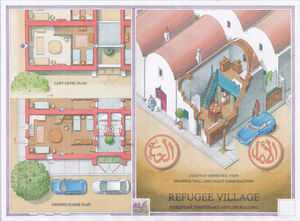 Refugee housing floor plan
Refugee housing floor plan
(Click for larger image)
Fleeing the wars of Syria, Afghanistan, Iraq, Eritrea, Somalia and other countries, refugees in staggering and unprecedented numbers are swarming into Europe, some 800,000 so far this year alone. This global and increasingly catastrophic movement is likely not only to continue but even to increase, and the United Nations High Commissioner for Refugees has warned “it is imperative that the situation be managed in such a way as to minimize the risks of new problems being created.”
An innovative project to help manage the refugee crisis has recently been proposed by Richard M. Economakis, associate professor and director of graduate studies in the University of Notre Dame’s School of Architecture, and is now under consideration by officials of the United Nations, the European Union and the Greek government.
Economakis proposes the creation of temporary refugee villages on the Greek islands of Lesbos, Kos and other Mediterranean sites where refugees first arrive in Europe. The buildings would be constructed of sun-dried brick — or adobe — which is inexpensive, locally available and easily and quickly produced and assembled. A typical village, arranged in pinwheel fashion around a central square, would include 800 housing units, each accommodating up to 10 people, making for a total population of some 8,000, approximately equivalent to the number of refugees now arriving on Greek islands daily.
 Refugee village plan
Refugee village plan
(Click for larger image)
“I was motivated to make the proposal after becoming aware that refugees arriving in various Greek islands, often bringing small children and elderly family members with them, are left to sleep in the streets or in fields, unprotected from the elements and without basic services like sanitation, clinics, refectories and clothing dispensaries,” Economakis said. “Although most of the people arriving in Greece are keen to continue on to other countries in Europe, where jobs can be found more easily, most are required to wait two or more weeks while their asylum requests are processed. This has put huge strains on local communities, which are often vastly outnumbered by the refugees. Also, the first experience of refugees arriving in Europe is currently a bad one, as besides having to rough it in the open, most of them resort to begging for assistance.”
Economakis said that the project is intended to provide short-term relief for as long as the refugee crisis endures, but added that “it has been pitched in a way that can encourage investment, even from the private sector, which in cash-strapped Greece should be especially welcome, and to reassure worried locals that the complexes are not designed to be permanent settlements, even though they could be put to profitable use if they were eventually re-purposed.”
Among other advantages in his proposal, Economakis spoke of its environmental impact in comparison with that of the refugee housing now available. “IKEA, for instance, has produced a lightweight unit made of industrial materials with a three-year life span,” he said. “That will leave an enormous carbon footprint, and its eventual disposal will be greatly damaging to the environment. Adobe construction is a zero-impact approach which can also facilitate re-usability. It is my hope that, in rushing to deal with the crisis, European and other countries affected by it will be willing to consider ways to create humane urban settings with the most environmentally responsible techniques.”
Contact: Richard Economakis, 574-631-7887 (office), 574-386-9266 (cell), economakis.1@nd.edu